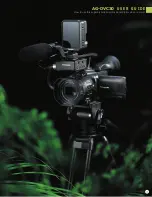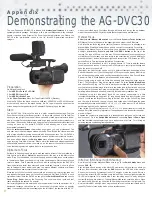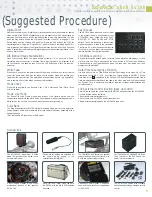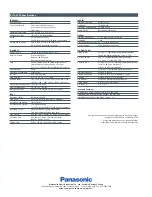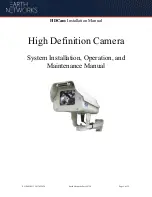
12
C A S E S T U D Y
1
A c t i v e M o t i o n
Shooting a Live Performance
This is a camera-recorder designed to meet the many demands
of on-site shooting.
After recording parts of the performance with the camera-recorder mounted on a tripod,
you can move around the venue in handheld mode to capture the mood.
Direct Audio Input from a Mixer
The AG-DVC30 is equipped with an XLR jack, making it possible to connect two audio
input lines and eliminating the need to use a gun microphone. The cable can be bound
to the handle so that it won t get in the way when doing handheld shooting.
XLR Jack for Audio Input
You can input audio directly from a mixing
console. However, since this is the mixed
output from the stage, it will not include
applause or other ambient sounds produced
by the audience. To capture the ambience,
place a small fixed video camera-recorder in
the venue and leave it running. Later, during
editing, material from the small camera-
recorder can be mixed in as desired. It is
also possible to use an MD recorder, rather
than a camera-recorder, for this purpose.
The first thing that struck me
about the AG-DVC30 is its
appealing style. The camera-
recorder’s black body is short and
stout, which could be considered
clunky and unsophisticated. But
to me it looked reliable and
intrepid: a trustworthy companion
ready for anything. The AG-
DVC30 is a digital video camera-recorder with many different faces. One
thing we could find was that it was more customizable than the Sony
PD150/PD170. For example, the Sony PD150 does not allow you to record
audio unless you connect a microphone to the Canon jack, whereas the
AG-DVC30 is equipped with a built-in stereo microphone. This means you
can record audio even with the camera-recorder in its most minimal,
stripped down, configuration. Furthermore, the handle and Canon adapter
can be combined freely, and the mounting system, which uses a shoe and
thumbscrew, is simple, secure, and reliable.
The lens is a 16x zoom with a field angle range of 39.5 to 632 mm (35 mm
equivalent). This puts it near the head of the field of currently available
digital video camera-recorders in zoom magnification. To be honest, I wish
the AG-DVC30 also offered a wider field angle, but that can be remedied
by mounting a wide conversion lens.
I also think it is great that Panasonic has focused its attention on dynamic
digital video. While I can understand the attraction and effectiveness of still
photography, there is really no need to add a half-baked still photo
function to a digital video camera-recorder when digital still cameras have
become as advanced as they are today. The AG-DVC30 truly embodies
the maxim “simple is best.” At the same time, it incorporates a lot of
usability features that show considerable attention to detail.After operating
the AG-DVC30 for a while and loading a variety of settings, I gave some
thought to the ways this camera-recorder could be used in different
situations. The live performance pictured here is one such situation. There
are a number of different approaches that can be taken when capturing a
live performance, and the AG-DVC30 seems to be well suited to this sort
of application.
The 16x zoom function is a powerful tool when you are recording a
performance from the rear of the venue, with the camera-recorder
mounted on a tripod. It is also possible to use the camera-recorder in
handheld mode, approaching the
musicians close and moving
around to provide increased
impact.
You can input audio directly from
a mixing console via the camera-
recorder’s Canon jack. As long as
you make sure the volume is set
appropriately ahead of time,
there’s no need to make further
adjustments while the show is in
progress. In effect, you’re leaving everything up to the person controlling
the mixer.
The next settings are the user buttons. The USER 1 button is located
behind the zoom lever, and USER 2 and USER 3 are on the left side of the
lens. I assigned the auto-focus function to USER 1, the spotlight function to
USER 2, and the one-push auto-zoom function to USER 3. Though the
functions I assigned to USER 1 and USER 3 are both related to auto-focus,
they are used differently. With the auto-focus function assigned to USER 1,
it is possible even while operating the focus ring with your left hand to
employ the auto-focus function momentarily as needed, using the index
finger of your right hand. The one-push auto-zoom function assigned to
USER 3 also uses auto-focus functionality. It simultaneously maximizes the
zoom setting and focuses the image. Though it’s a little unorthodox, I like
to use this function to quickly zoom in and out on a subject. The effect it

















